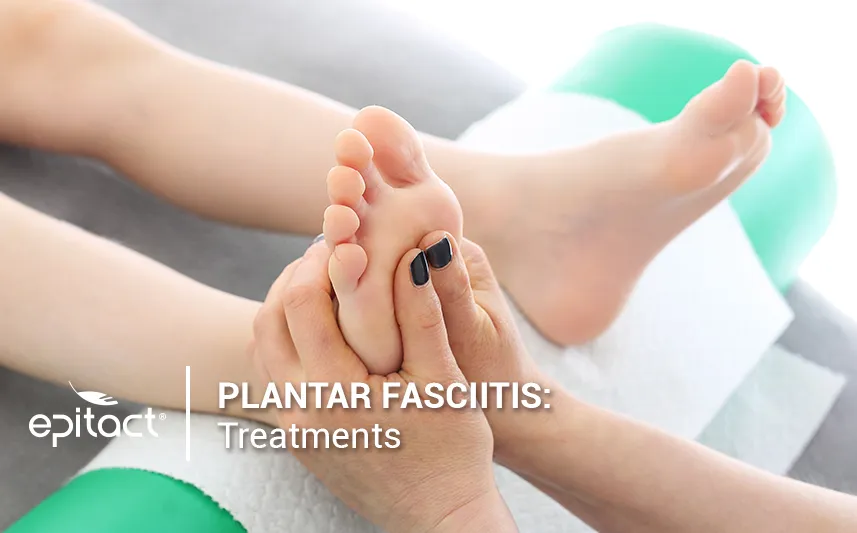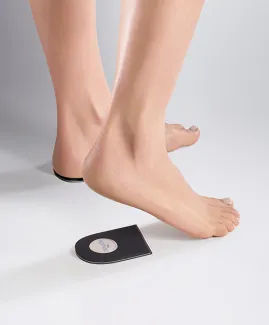
Plantar fasciitis is one of the most frequent reasons for consultation in the podiatric field(1). This inflammation of the plantar fascia (the fibrous band that runs along the sole of the foot) causes persistent pain.
There are home treatments for plantar fasciitis that help to reduce inflammation. If pain is too intense or persistent, other medical and surgical options exist. Discover how to cure plantar fasciitis and its main treatments: prevention, medication, exercises, shock waves and surgery.
Heel spur and plantar fasciitis: is the treatment the same?
Very often, the presence of a heel spur is considered as responsible for heel pain. However, there is a great confusion regarding these two closely related conditions.
When the plantar fascia is subject to excessive stress, it triggers the formation of a heel spur. Such overuse causes microtraumas on the fascia and leads to its inflammation. The spur precisely develops where the plantar fascia attaches to the heel bone (calcaneus).
To sum up, it is not the heel spur that causes pain but rather the inflammation of the plantar fascia. Since they have similar causes and symptoms, their treatments are also very close. EPITACT® reports the 6 different treatments of plantar fasciitis.
Step 1: how to cure plantar fasciitis by fighting against the risk factors?
The treatment of plantar fasciitis, no matter the stage and intensity of pain, begins by eliminating the causes and factors that aggravate the inflammation. In other words, it consists in limiting the situations that cause stress to the plantar fascia in different ways.
Wearing heel lifts or insoles
Whether orthotics are usually recommended for the treatment of static disorders (hyperpronated, hollow or flat feet), shoe inserts immediately reduce the stress on the fascia(2). To cure plantar fasciitis, EPITACT® suggests you the heel lifts* partly made of silicone. They cushion the shocks under the heel and soothe pain while slightly lifting the heel. As they are adhesive and ultra-thin, they stay very well in place in the shoe and provide comfort at each step.
Resting the foot
Prolonged standing positions and intense sports practice are risk factors for plantar fasciitis. For sportspersons, especially runners, the treatment of plantar fasciitis consists in adapting the frequency, intensity and duration of the activity and limiting practice on hard surfaces. In acute stages, it is important to favour sports like swimming or cycling for example. To relieve the plantar fascia, 2 weeks of rest are necessary(3) to reduce inflammation and pain.
Wearing well-fitting shoes
Choose supportive shoes with a comfortable and relatively thick sole that cushion shocks and pressure on the plantar fascia. They must also fit the shape of your foot in order to support it properly. For example, avoid flat shoes that poorly support the heel and arch of the foot with sole and materials that do not provide effective shock absorption.
Losing weight
It is important to have a balanced diet because being overweight increases the pressure and stress on the heel. It can contribute to overusing the plantar fascia. These four home treatments for plantar fasciitis are also preventive measures.
Step 2 for plantar fasciitis treatment: medication
Additionally, the treatment of plantar fasciitis can include analgesics and non-steroidal anti-inflammatory drugs(4). These are symptomatic treatments with temporary effects on pain and inflammation.
Step 3: stretching exercises is a home treatment for plantar fasciitis
Doing exercises to stretch the plantar fascia, either with a physiotherapist or at home is a treatment of plantar fasciitis. Physical therapy can be completed by massages of the sole of the foot. EPITACT® has gathered for you some simple exercises to improve the symptoms related to this inflammation under the foot.
It is also possible to relieve pain by applying something cold on the painful area, especially in the beginning of the condition. Take a frozen water bottle and make it roll on the bottom of your foot, 10 to 20 minutes, 2 to 4 times per day(3).
Fortunately, if the combination of the treatments for plantar fasciitis listed above is not sufficient after 3 months, other options exist.
Step 4: how to cure plantar fasciitis with corticosteroid injections
Corticosteroid injections at the insertion point of the plantar fascia on the calcaneus can reduce inflammation. Only 3 successive injections are possible, with a minimal interval of one week between each of them(5).
However, it has been proved that this way to cure plantar fasciitis has only short-term effectiveness on inflammation. Injections can possibly be used as a first line approach if pain is unbearable or if the condition is too severe.
Step 5 in the treatment for plantar fasciitis: shock waves
If the previous treatments have been insufficient, the effects of shock waves are positive on plantar fasciitis symptoms(6). The main objectives of this non-invasive treatment are to destroy the damaged fibres and to boost the production of collagen. Indeed, the plantar fascia is a fibrous membrane mainly composed of collagen.
Step 6: surgery to treat plantar fasciitis
Surgery is only considered if the patient has not responded well to the previous plantar fasciitis treatments options. It is rarely performed since 90 to 96% of cases of plantar fasciitis are cured with conservative treatments like those listed above(5). Also, in some situations, surgery causes irremediably collapse of the foot arch because of the fascia incision.
For more information about the surgical treatment of plantar fasciitis, please refer to our article here.
You’ve understood how to cure plantar fasciitis. According to the stage of your condition, there are home treatments for plantar fasciitis and treatments supervised by a health professional. To conclude, the treatment of plantar fasciitis is mainly preventive and medical.
Fighting against its risk factors can reduce pain and inflammation, but can also avoid recurrence! However, each person is unique and responds differently to the treatments prescribed to cure plantar fasciitis.

*This solution is a class I medical device that bears the CE marking under this regulation. Carefully read the instructions before use. Manufacturer: Millet Innovation. 01/2022
For more details about this general and simplified approach, here are further sources:
(1)Gonzalez-Martin C, Pertega-Diaz S, Seijo-Bestilleiro R, Garcia-Rodriguez MT. Satisfaction with Orthopedic Treatments [Internet]. Prosthetics and Orthotics. IntechOpen; 2021 [cité 8 déc 2021]. Disponible sur: https://www.intechopen.com/chapters/76832
(2)Drake M, Bittenbender C, Boyles RE. The Short-Term Effects of Treating Plantar Fasciitis With a Temporary Custom Foot Orthosis and Stretching. J Orthop Sports Phys Ther. 1 avr 2011;41(4):221‑31. 2014;10:241 2.
(3)Hasegawa M, Urits I, Orhurhu V, Orhurhu MS, Brinkman J, Giacomazzi S, et al. Current Concepts of Minimally Invasive Treatment Options for Plantar Fasciitis: a Comprehensive Review. Curr Pain Headache Rep. sept 2020;24(9):55.
(4)Luffy L, Grosel J, Thomas R, So E. Plantar fasciitis: A review of treatments. Journal of the American Academy of Physician Assistants. janv 2018;31(1):20‑4.
(5)Kahn M-F, Bardin T, Dieudé P, Lioté F, Meyer O, Orcel P, et al. L’actualité rhumatologique 2013. Elsevier Health Sciences; 2013.
(6)Aqil A, Siddiqui MRS, Solan M, Redfern DJ, Gulati V, Cobb JP. Extracorporeal Shock Wave Therapy Is Effective In Treating Chronic Plantar Fasciitis: A Meta-analysis of RCTs. Clinical Orthopaedics & Related Research. nov 2013;471(11):3645‑52.
 Pharmacie
Pharmacie